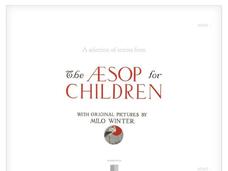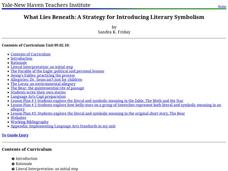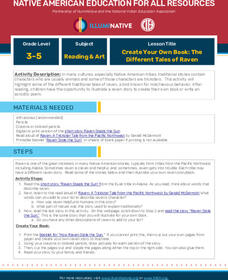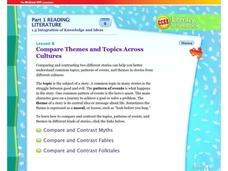Core Knowledge Foundation
Second Grade Skills Unit 2: Bedtime Tales
A unit covering second-grade skills reviews 16 letter-sound correspondences, tricky words, and punctuation. Readers provide context for examining story elements, and pupils participate in close reading and write narratives retelling a...
Core Knowledge Foundation
Fables and Stories Tell It Again!™ Read-Aloud Anthology
A read-aloud anthology focuses on fables. Over three weeks, first graders listen to various stories and then participate in lessons that cover story elements, including plot, characters, setting, and personification and explore...
Core Knowledge Foundation
First Grade Skills Unit 3
Four weeks, 19 lessons—this unit covers five new vowel spelling patterns, tricky words, spellings, verb tenses, reading fables and exploring the writing process. Lessons offer review, an introduction to the concept, skills practice,...
Core Knowledge Foundation
Nursery Rhymes and Fables Tell It Again!™ Read-Aloud Anthology
A 206-page kindergarten anthology offers various nursery rhymes and fables. Each lesson covers a different reading and examines a concept that best relates to the rhyme or fable. Lessons begin with an introduction to the reading, go into...
Library of Congress
A Selection of Stories from The Æsop for Children
Read and incorporate a variety of Aesop's Fables into a fable genre study with an eBook produced by the Library of Congress. The interactive eBook contains 146 fables written by Aesop and includes colorful interactive illustrations...
Weekly Story Book
Folk Tales and Fables
Pages and pages of engaging activities, worksheets, and writing projects on teaching folktales and fables await you! You don't want to miss this incredible resource that not only includes a wide range of topics and graphic...
Scholastic
Folk and Fairy Tale Readers: The City Mouse and the Country Mouse
Support the growth of your emergent readers with this printable version of the classic fable "The City Mouse and the Country Mouse." Including supporting illustrations and simple dialogue, this story is perfect for developing the...
Scholastic
Folk and Fairy Tale Readers: The Tortoise and the Hare
Slow and steady wins the race to fluent reading with this printable version of "The Tortoise and the Hare". Presenting children with fun illustrations and a repetitive story structure, this resource is perfect for developing...
Scholastic
Folk and Fairy Tale Readers: The Three Little Pigs
Engage young learners in developing their reading fluency with their very own copy of The Three Little Pigs. Including a series fun illustrations, children will have a hard time putting this book down.
Yale University
What Lies Beneath: A Strategy for Introducing Literary Symbolism
“It’s not about what it is, it’s about what it can become.” You’re never too old for Dr. Seuss and using The Sneetches and The Lorax is a great way to introduce readers to allegories, parables, and literary symbolism. The lessons...
Curated OER
Character Traits in Fables
Combining art, music, dance, and reading comprehension, this lesson is geared to reach all ability levels. After reading a variety of fables and discussing story elements and character traits, class members select a moral to use as the...
Curated OER
Critical Thinking With Fables New and Old
Explore the fables of today along with Aesop's ancient fables. Learners will understand the structure of a fable, critically think about the fable's message, and create a lesson that they would like to teach through a fable. Suggested...
Curated OER
Create Your Own Book: The Different Tales of Raven
The raven is the focus of a lesson that examines trickster tales and the different stories about the bird. After listening to three tales about the raven, scholars pinpoint and discuss descriptive words. Pupils use one story to...
K20 LEARN
Here's How I Heard It: Using Folklore To Improve Close Reading Skills
"X" is for exaggeration, and "F" is for fact. To encourage close reading and to improve literary analysis skills, class members annotate fables and tall tales, like Paul Bunyan, with symbols that identify key features of this genre.
Penguin Books
A Teacher's Guide to the Signet Classic Edition of George Orwell's Animal Farm
Not all teacher's guides are equal, but some are pretty good. This guide for George Orwell's Animal Farm includes chapter synopses, chapter-by-chapter discussion questions, journal and essay prompts, and suggestions for various activities.
Nemours KidsHealth
Self-Esteem: Grades 3-5
Two lessons examine self-esteem and encourage scholars to exude confidence. Lesson one asks learners to recognize the characteristics of self-esteem then create a collage compiled of images that reflect their skills, accomplishments, and...
American Museum of Natural History
Silk Road Fables
Talk about rabbit holes! With just this one resource, learners can travel the Silk Road listening to fables, meet a scientist who studies poisons (and whose favorite book is Alice in Wonderland), and listen to a video interview of an...
Great Books Foundation
The Fox and the Stork
Young readers take part in a meaningful discussion following a reading of Aesop's fable "The Fox and the Stork." Five questions focus on the characters' actions and offering apologies.
Fluence Learning
Writing an Opinion: Is Pride Good or Bad?
Does pride really goeth before the fall, or can it be essential to one's development? Second graders read two of Aesop's fables that refer to pride in their morals, and write a short essay about whether pride is good or bad, based on...
Nosapo
Reading Activity: Circle the Right
Fables can teach us about life's morals, but they are also helpful for reviewing verb tense, spelling, and word choice. Three reading passages feature well-known fables, each with several opportunities for students to circle the correct...
McGraw Hill
Compare Themes and Topics Across Cultures
Compare and contrast folktales, myths, and fables in an interactive eBook. The interactive is broken up into three topics: myths, fables, and folktales. Each section includes a reading passage and a guided lesson on the theme, topic, and...
English Worksheets Land
The Donkey, the Fox and the Lion
Have learners read about a lion that lures a foolish fox into a trap and gets himself and his donkey friend eaten. After reading, pupils answer three questions and determine what the lesson of the story is.
English Worksheets Land
That Darn Cat!
Read about the darnedest can in two fables adapted from Aesop's Fables. Readers answer three reading comprehension questions that prompt them to compare and contrast animal characters in the two stories.
Read Works
The Boy Who Cried Wolf
Reinforce reading comprehension strategies and contemplate an important life lesson with a learning exercise featuring Aesop's fable, The Boy Who Cried Wolf. After reading a brief passage, scholars show what they know by...

























